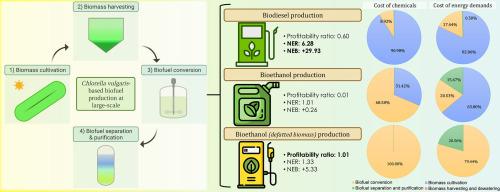Cost-effective large-scale production of Chlorella vulgaris-based biodiesel and bioethanol: A comparative assessment
IF 6.3
3区 工程技术
Q1 ENGINEERING, CHEMICAL
Journal of the Taiwan Institute of Chemical Engineers
Pub Date : 2025-09-23
DOI:10.1016/j.jtice.2025.106395
引用次数: 0
Abstract
Background
Microalgae-based biofuel production is a promising alternative to conventional renewable energy sources, despite its economic viability at industrial scale remains unrealized. The present study is the first to present a novel evaluation of large-scale biodiesel and bioethanol production from Chlorella vulgaris, integrating the cost analysis of chemicals and energy demands, to identify the most viable production route for real-world implementation.
Methods
Three biofuel production routes, namely, biodiesel via two-step transesterification and bioethanol from whole and defatted biomass through acid hydrolysis, were systematically assessed, with a functional unit of 1000 kg (dry biomass) of C. vulgaris.
Significant findings
Total costs associated with chemicals and energy demands were $ 2.30/L, $ 95.52/L, and $ 0.73/L to produce biodiesel, bioethanol, and defatted biomass-based bioethanol, respectively. Consequently, the most profitable biofuel production using defatted C. vulgaris biomass has a profitability ratio of 1.01 (>1). Moreover, biodiesel production demonstrates the most renewable system with a net energy ratio of 6.28 and a net energy balance of +29.93. Nonetheless, the production viability of biodiesel and bioethanol (whole biomass) could be enhanced by incorporating cost- and energy-effective strategies. Additionally, the valorization of defatted biomass for bioethanol production would be a promising strategy, facilitating a circular bioeconomy and enhanced sustainability.

基于小球藻的生物柴油和生物乙醇的成本效益规模化生产:比较评估
基于微藻的生物燃料生产是传统可再生能源的一个有前途的替代品,尽管其在工业规模上的经济可行性尚未实现。本研究首次对小球藻大规模生产生物柴油和生物乙醇进行了新的评估,整合了化学品和能源需求的成本分析,以确定现实世界中最可行的生产路线。方法以1000 kg(干生物质)为功能单位,系统评价了两步酯交换法制备生物柴油和酸水解法制备脱脂生物质乙醇3种生物燃料生产路线。生产生物柴油、生物乙醇和脱脂生物质生物乙醇,与化学品和能源需求相关的总成本分别为2.30美元/升、95.52美元/升和0.73美元/升。因此,利用脱脂C. vulgaris生物质生产最有利可图的生物燃料的盈利比率为1.01 (>1)。此外,生物柴油生产是最可再生的系统,净能量比为6.28,净能量平衡为+29.93。尽管如此,生物柴油和生物乙醇(整个生物质)的生产能力可以通过纳入成本和能源有效战略来提高。此外,用于生物乙醇生产的脱脂生物质的增值将是一个有前途的战略,促进循环生物经济和增强可持续性。
本文章由计算机程序翻译,如有差异,请以英文原文为准。
求助全文
约1分钟内获得全文
求助全文
来源期刊
CiteScore
9.10
自引率
14.00%
发文量
362
审稿时长
35 days
期刊介绍:
Journal of the Taiwan Institute of Chemical Engineers (formerly known as Journal of the Chinese Institute of Chemical Engineers) publishes original works, from fundamental principles to practical applications, in the broad field of chemical engineering with special focus on three aspects: Chemical and Biomolecular Science and Technology, Energy and Environmental Science and Technology, and Materials Science and Technology. Authors should choose for their manuscript an appropriate aspect section and a few related classifications when submitting to the journal online.

 求助内容:
求助内容: 应助结果提醒方式:
应助结果提醒方式:


